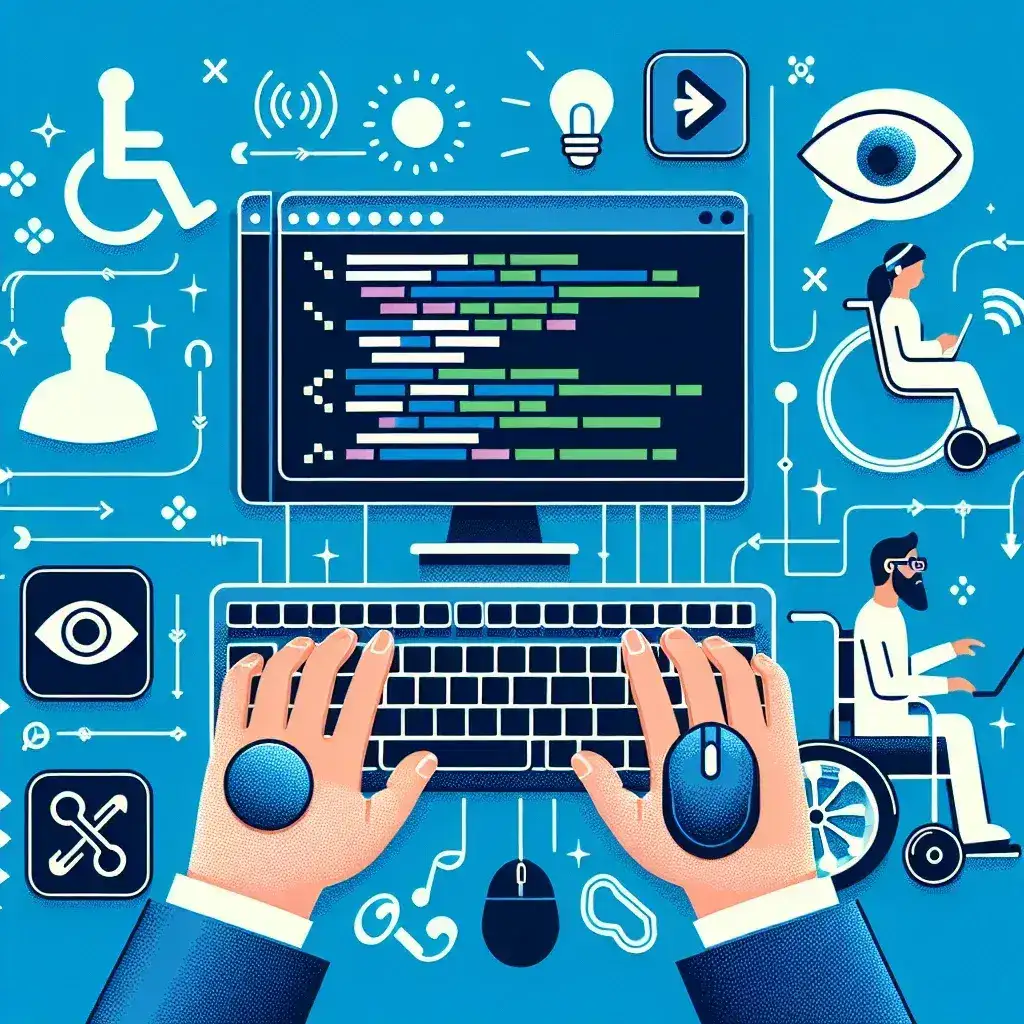In the world of web development, creating accessible websites is not just a moral obligation but a legal and business necessity. Accessibility, often abbreviated as a11y, ensures that everyone, regardless of their abilities or disabilities, can navigate, understand, and interact with your web content. This article delves into the basics of web accessibility, providing modern developers with a solid foundation to build inclusive and user-friendly websites.
Understanding Web Accessibility (a11y)
Web accessibility is the practice of designing and developing websites that are usable by people with a wide range of abilities. This includes individuals with visual, auditory, physical, speech, cognitive, and neurological disabilities. By making your website accessible, you not only expand your user base but also comply with legal standards and enhance the overall user experience.
The Importance of Accessibility
- Legal Compliance: Many countries have laws and regulations that require websites to be accessible, such as the Americans with Disabilities Act (ADA) in the United States and the European Union’s Web Accessibility Directive.
- Broadening Your Audience: Accessible websites cater to a larger and more diverse audience, which can lead to increased traffic and better engagement.
- Enhanced User Experience: Accessibility improvements often benefit all users, not just those with disabilities, making your website more intuitive and user-friendly.
- SEO Benefits: Accessible websites tend to have better SEO rankings because they are easier for search engines to crawl and index.
Key Accessibility Principles
The Web Content Accessibility Guidelines (WCAG) provide a set of recommendations for making web content more accessible. Here are the four main principles:
Perceivable
Information and user interface components must be presentable to users in ways they can perceive. This means that users must be able to perceive the information being presented (it can’t be invisible to all of their senses).
- Text Alternatives: Provide text alternatives for non-text content so that it can be changed into other forms people need, such as large print, braille, speech, symbols, or simpler language.
- Adaptable: Create content that can be presented in different ways without losing information or structure, such as simpler layout.
- Distinguishable: Make it easier for users to see and hear content, including separating foreground from background.
Operable
User interface components and navigation must be operable. This means that users must be able to operate the interface (the interface cannot require interaction that a user cannot perform).
- Keyboard Accessible: Ensure that all functionality can be accessed via the keyboard alone.
- Enough Time: Provide users with enough time to read and use content.
- Seizures and Physical Reactions: Do not design content in a way that is known to cause seizures or physical reactions.
- Navigable: Provide ways to help users navigate, find content, and determine where they are.
Understandable
Information and the operation of the user interface must be understandable. This means that users must be able to understand the information as well as the operation of the user interface (the content or operation cannot be beyond their understanding).
- Readable: Make text content readable and understandable.
- Predictable: Make web pages appear and operate in predictable ways.
- Input Assistance: Help users avoid and correct mistakes.
Robust
Content must be robust enough that it can be interpreted reliably by a wide variety of user agents, including assistive technologies. This means that users must be able to access the content as technologies advance (as technologies and user agents evolve, the content should remain accessible).
- Compatibility: Maximize compatibility with current and future user tools, including assistive technologies.
Implementing Accessibility in Your Code
Now that you understand the principles of web accessibility, let’s dive into how you can implement these in your code.
HTML Semantics
Using semantic HTML is one of the most fundamental steps in creating an accessible website. Semantic HTML helps convey the meaning of the content and its structure to assistive technologies and search engines.
- Use Heading Tags Correctly: Headings (h1, h2, h3, etc.) should be used in a logical order to create a clear hierarchy of content.
- Label Form Elements: Use the
<label>tag to associate text labels with form elements, and usearia-labeloraria-labelledbyfor additional context. - Use ARIA Roles and Properties: Accessible Rich Internet Applications (ARIA) roles and properties can enhance accessibility by providing additional information to assistive technologies.
- Ensure Proper Use of Landmarks: Use ARIA landmarks (e.g.,
role="main",role="navigation",role="footer") to help users navigate your site.
Color Contrast and Visual Design
Color contrast is crucial for users with visual impairments. Ensure that text and background colors have sufficient contrast to be easily readable.
- Use WCAG Color Contrast Guidelines: The WCAG 2.1 guidelines recommend a contrast ratio of at least 4.5:1 for normal text and 3:1 for large text.
- Avoid Using Color Alone: Do not rely solely on color to convey information. Use text, icons, or other visual cues to complement color-based information.
- Test with Tools: Use tools like the WebAIM Color Contrast Checker to ensure your color choices meet accessibility standards.
Keyboard Navigation
Not all users interact with websites using a mouse. Some users rely on keyboard navigation, so it’s important to ensure your site is fully navigable using a keyboard.
- Focus Management: Manage focus states to ensure that users can navigate through all interactive elements in a logical order.
- Focus Styles: Provide visible focus styles for interactive elements to help users understand where they are on the page.
- Accessible Modals: Ensure that any modal dialogs or pop-ups can be closed using the keyboard and that focus is returned to the element that triggered the modal.
Screen Reader Compatibility
Screen readers are essential tools for users who are blind or have low vision. Ensure that your website is compatible with screen readers by following these best practices:
- Use Semantic HTML: As mentioned earlier, semantic HTML helps screen readers understand the structure and purpose of your content.
- Alt Text for Images: Provide descriptive alt text for all images to convey their purpose and content.
- ARIA Labels: Use ARIA labels to provide additional context for elements that may not be clear to screen reader users.
- Dynamic Content Updates: Use ARIA live regions to notify screen reader users of dynamic content changes, such as updates to a shopping cart or notifications.
Responsive Design
Responsive design ensures that your website is usable on a variety of devices and screen sizes. This is particularly important for users with motor disabilities who may use different devices or assistive technologies.
- Flexible Layouts: Use CSS to create flexible layouts that adapt to different screen sizes and orientations.
- Touch-Friendly Design: Ensure that interactive elements are large enough to be easily tapped on touch screens.
- Responsive Images: Use the
<img>tag with thesizesandsrcsetattributes to serve appropriate images for different devices.
Testing and Validation
Testing your website for accessibility is an ongoing process. Here are some tools and methods to help you ensure your site meets accessibility standards:
- Automated Testing Tools: Use tools like Axe, Wave, and Lighthouse to automatically check for common accessibility issues.
- Manual Testing: Conduct manual testing using keyboard-only navigation and screen readers like NVDA, JAWS, and VoiceOver.
- User Testing: Involve users with disabilities in your testing process to get real-world feedback and identify issues that automated tools might miss.
- Regular Audits: Perform regular accessibility audits to catch and fix issues as they arise.
Common Accessibility Mistakes to Avoid
While implementing accessibility, it’s important to be aware of common mistakes that can hinder your efforts. Here are a few to watch out for:
- Ignoring Keyboard Navigation: Many developers forget to test their sites for keyboard navigation, which can leave a significant portion of users unable to use the site.
- Overusing ARIA: ARIA should be used to enhance accessibility, not replace semantic HTML. Overusing ARIA can lead to confusion and reduced usability.
- Poor Color Contrast: Failing to meet color contrast guidelines can make your site difficult or impossible for users with visual impairments to read.
- Inaccessible Forms: Forms without proper labels, focus management, and error handling can be frustrating for users with disabilities.
Best Practices for Modern Developers
To create truly accessible websites, modern developers should adopt the following best practices:
- Stay Updated: Keep up with the latest accessibility guidelines and standards, such as WCAG 2.1 and 2.2.
- Use Accessibility Linters: Integrate accessibility linters into your development workflow to catch issues early.
- Design for Inclusion: Consider accessibility from the very beginning of the design process, not as an afterthought.
- Provide Alternative Text: Always provide alternative text for images, videos, and other multimedia content.
- Ensure Consistent Navigation: Use consistent navigation patterns and labels across your site to make it easier for users to understand and use.
- Accessible Animations: Provide options to reduce or disable animations for users who may find them distracting or triggering.
Conclusion
Accessibility is a critical aspect of modern web development. By following the principles and best practices outlined in this article, you can create websites that are inclusive, user-friendly, and legally compliant. Remember, accessibility is not a one-time task but an ongoing commitment. Regular testing and updates are essential to maintaining an accessible site. Embrace accessibility as a core part of your development process, and you’ll not only improve the user experience for everyone but also build a stronger, more robust web presence.
For more information and resources on web accessibility, check out the Web Content Accessibility Guidelines (WCAG) and the A11y Project.









